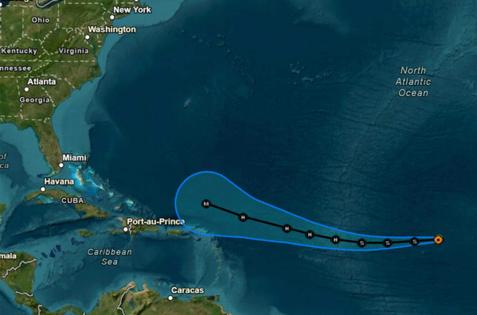Tropical Storm Erin surges through Atlantic, still forecast to be major hurricane, NHC says
Published in Weather News
ORLANDO, Fla. — Tropical Storm Erin on Tuesday continued to push west through the Atlantic with the National Hurricane Center still forecasting it to become a major hurricane.
As of the NHC’s 5 a.m. update, the center of Erin was located about 1,890 miles east of the northern Leeward Islands of the Caribbean moving west at 22 mph with maximum sustained winds of 45 mph. Tropical-storm-force winds extend out 45 miles.
“This motion is expected to continue for the next several days with a decrease in forward speed and a gradual turn toward the west-northwest,” said NHC senior hurricane specialist Richard Pasch. “Gradual strengthening is forecast over the next several days, and Erin is expected to become a hurricane in the next couple of days.”
The long-range forecast from the NHC has it intensifying into what would be the season’s first hurricane with 75 mph sustained winds, making it a Category 1 hurricane, by early Thursday morning.
“The official intensity forecast is at the high end of the model guidance and shows Erin becoming a major hurricane in around 5 days,” Pasch said. “There is significant uncertainty in intensity predictions at this time range.”
The forecast predicts it will grow into a major Category 3 hurricane with 115 mph sustained winds and gusts of 140 mph by early Sunday morning with the cone of uncertainty encompassing a wide swath in the Atlantic just northeast of the Leeward Islands. Winds could potentially be felt in the islands beginning Friday night.
The National Weather Service in Melbourne said it was too early to determine if there would be any Florida impacts.
“We are entering peak hurricane season. Use this time to ensure you are prepared ahead of any threats,” forecasters said.
Computer modeling forecast tracks from Monday mostly show the storm veering to the north before it would threaten the U.S. but patterns can change.
The NHC also is tracking one other Atlantic systems and a system in the Gulf.
Tropical Storm Erin on Tuesday continued to push west through the Atlantic with the National Hurricane Center still forecasting it to become a major hurricane.
As of the NHC’s 8 a.m. tropical outlook, the Atlantic systems had only a 10% chance of development and the Gulf system had 0% percent chance, but forecasters warned of tropical rainfall over the Gulf coast.
The surface trough that was near the coast of Louisiana had a broad area of disorganized showers and thunderstorms.
“While development of this system is not anticipated before it moves inland later today, locally heavy rainfall could produce flash flooding across portions of the northern Gulf coast over the next day or so,” forecasters said.
The remaining system was a nontropical area of low pressure a few hundred miles southeast of Nova Scotia, Canada, with disorganized shower and thunderstorm activity.
“Some limited tropical or subtropical development is possible over the next day or so as the low meanders near the relatively warm waters of the Gulf Stream,” forecasters said. “The system is expected to move northward over cooler waters by Wednesday, ending its chances for tropical development.”
After Erin, the next names on the 2025 Atlantic hurricane season would be Fernand and Gabrielle.
The National Oceanic and Atmospheric Administration last week updated its season forecast now calling for 13-18 named storms for the year, of which five to nine would grow into hurricanes. Two to five of those would develop into major hurricanes of Category 3 strength or higher.
The height of hurricane season runs from mid-August into October while the entire six-month season runs June 1 to Nov. 30.
-------------
©2025 Orlando Sentinel. Visit at orlandosentinel.com. Distributed by Tribune Content Agency, LLC.







Comments